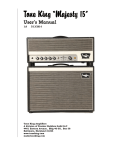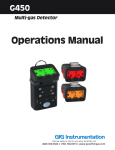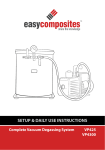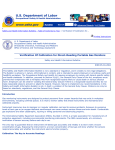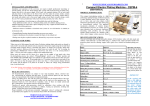Download Verification Of Calibration for Direct-Reading
Transcript
U. S. Department of Labor Occupational Safety and Health Administration Directorate of Science, Technology and Medicine Office of Science and Technology Assessment Verification Of Calibration for Direct-Reading Portable Gas Monitors Introduction Gas monitoring instruments are designed to protect personnel from unseen hazards that may exist in workplace environments, including confined spaces. It is vital to worker safety that these instruments are maintained and calibrated properly. Instrument inaccuracy due to improper or irregular calibration can lead to serious accidents. Exposure to excessive levels of toxic gas or an oxygen-deficient environment can cause workers serious illness and even death. Combustible gas explosions are often catastrophic, injuring or killing personnel and destroying property. The International Safety Equipment Association (ISEA), founded in 1933, is a trade association for manufacturers of protective equipment, including environmental monitoring instruments. The ISEA recommends, at a minimum, verification of sensor accuracy before each day’s use. The only way to guarantee that an instrument will detect gas accurately and reliably is to test it with a known concentration of gas. Exposing the instrument to a known concentration of test gas will show whether the sensors respond accurately and whether the instrument alarms function properly. Calibration: The Key to Accurate Readings Gas detection instruments are used to detect the presence of toxic and combustible gases, as well as oxygen deficiency or oxygen enrichment (a fire and explosion hazard). Workers cannot rely on their sense of smell to alert them to odorless hazards, necessitating the use of gas detectors whenever a worker enters an area with potential atmospheric hazards. “Calibration” refers to an instrument’s measuring accuracy relative to a known concentration of gas. Gas detectors measure the concentration of a gas in an air sample by comparing the sensor’s response to the response generated by a calibration gas of a known concentration. The instrument’s response to the calibration gas serves as the measurement scale or reference point. The responsiveness of electrochemical sensors will vary with environmental conditions. Sensor response will be different (lower or higher) depending on the actual environmental conditions. Therefore, as much as possible, the monitors should be calibrated at environmental conditions that are the same as (or similar to) actual field conditions. Calibration at locations where the equipment is to be used is always preferable. Most instruments are equipped with two levels of alarms – warning and danger. The warning alarm alerts the user that the environment has a detectable concentration of gas and is therefore potentially hazardous. The danger alarm indicates that the gas concentration exceeds the programmed “hazard” threshold, and the area is approaching a hazardous level. Whether an instrument warns and/or alarms at the proper time depends on its detection abilities and its ability to translate its findings into an accurate reading. If the instrument’s reference point has shifted, the reading will shift accordingly and be unreliable. This is called “calibration drift” and it happens to all detectors over time. An instrument that experiences calibration drift can still measure the quantity of gas present but it cannot convert this information into an accurate numerical reading. Regular calibration with a certified standard gas concentration will update the instrument’s reference point, ensuring that the instrument will produce continued, accurate readings. Causes of Calibration Drift Over time, the accuracy of gas detection instruments can diverge from their calibration settings in several ways: Gradual chemical degradation of sensors and drift in electronic components that occur naturally over time. Chronic exposures to, and use in, extreme environmental conditions, such as high/low temperature and humidity, and high levels of airborne particulates. Exposure to high (over-range) concentrations of the target gases and vapors. Chronic or acute exposure of catalytic hot-bead LEL sensors to poisons and inhibitors. These include: volatile silicones, hydride gases, halogenated hydrocarbons, and sulfide gases. Chronic or acute exposure of electrochemical toxic gas sensors to solvent vapors and highly corrosive gases. Harsh storage and operating conditions, such as when an instrument is dropped onto a hard surface or submerged in liquid. Normal handling/jostling of the equipment can create enough vibration or shock over time to affect electronic components & circuitry. Often, after exposure to the more extreme conditions above, when calibration is attempted, the detector will either display a failure message or it will not allow the user to fully adjust the display reading. At this point, the severely damaged sensor must be replaced and/or the detector serviced by qualified personnel. Worker Safety: The Number One Reason for Proper and Regular Calibration The primary reason for proper, regular instrument calibration is to prevent inaccurate gas concentration readings that could lead to injury or to death. Correctly calibrating an instrument helps to ensure that the instrument will accurately respond to the gases that it is designed to detect, warning users of hazardous conditions before they reach dangerous levels. In addition to detecting and correcting for calibration drift, regular calibration assures the user that the instrument is functional. Gas detection instruments are often subjected to harsh operating and storage conditions where they can be damaged. Both of these factors can affect instrument performance, leading to inaccurate readings or even instrument failure. While a unit may appear to be sound during a visual inspection, it actually could be damaged internally. Regular calibration is the only way to be certain that a detector is fully functional. Moreover, a standing policy for regular calibration sets the tone for a safety-conscious work environment and indicates to workers that safety is a priority. As a result, workers may be more likely to keep safety principles in mind throughout the workday. A written record of calibration should be kept for the life of each instrument. This record allows users to quickly identify an instrument that has a history of excessive maintenance/repair or is prone to erratic readings. Bump Tests vs. Full Calibration There are two methods of verifying instrument accuracy: a functional or bump test and a full calibration, each appropriate under certain conditions. A bump test verifies calibration by exposing the instrument to a known concentration of test gas. The instrument reading is compared to the actual quantity of gas present (as indicated on the cylinder). If the instrument’s response is within an acceptable tolerance range of the actual concentration, then its calibration is verified. (Note: It is recommended that users check with the detection equipment manufacturer for the acceptable tolerance ranges.) Instruments should be “zeroed” before the bump test in order to give a more accurate picture of the bump test results. When performing a bump test, the test gas concentration should be high enough to trigger the instrument alarm. If the bump test results are not within the acceptable range, a full calibration must be performed. A full calibration is the adjustment of the instrument’s reading to coincide with a known concentration (generally a certified standard) of test gas. For verification of accuracy, calibration gas should always be certified by and traceable to the National Institute of Standards and Technology (NIST). In most cases, a full calibration is only necessary when an instrument fails a bump test or after it has been serviced. The full calibration and bump test should be conducted in a clean fresh air environment. When to Bump Test and When to Calibrate In the past, there often has been confusion regarding proper calibration procedures and frequency. To clarify this issue, the International Safety Equipment Association (ISEA) issued a position statement on instrument calibration that states, “A bump test or full calibration of direct-reading portable gas monitors should be made before each day’s use in accordance with manufacturer’s instructions, using an appropriate test gas.” If the instrument fails a bump test, it must be adjusted through a full calibration before it is used. ISEA recommends more frequent testing if environmental conditions that could affect instrument performance are suspected, such as sensor poisons. The ISEA allows for less frequent calibration verification under certain conditions (see below), but the interval between testing should never exceed 30 days. According to the ISEA, less frequent verification may be appropriate if the following criteria are met: During a period of initial use of at least 10 days in the intended atmosphere, calibration is verified daily to ensure there is nothing in the atmosphere to poison the sensor(s). The period of initial use must be of sufficient duration to ensure that the sensors are exposed to all conditions that might adversely affect the sensors. If the tests demonstrate that no adjustments are necessary, the interval between checks may be lengthened, but it should not exceed 30 days. When calibrating an instrument, always follow the instrument user’s manual for the manufacturer’s recommended calibration frequency and procedure. Calibration Rules The following are a few basic instrument calibration rules to ensure a clear path to health and safety. Follow the manufacturer’s guidelines for proper calibration. No job, including instrument calibration, can be performed properly or safely without the right tools. The type and concentration of calibration gas, sample tubing, flow regulators and calibration adapters are key links in the calibration chain. Using equipment provided by the original manufacturer should ensure a proper start to every calibration. Only use certified calibration gas before its expiration date. The most important tool used in calibration is the gas itself. The instrument can only be as accurate as the gas used to calibrate it. Be certain your supplier can provide a traceable certificate of analysis for every calibration gas cylinder. The concentration of calibration gas, particularly the concentration of reactive gases such as hydrogen sulfide or chlorine, will only remain stable for a finite period of time. Never use calibration gas after its expiration date. Train workers on the proper methods of calibration. Most instruments are designed to be field calibrated with instructions detailed in user manuals, training videos or computer-based training modules. Everyone responsible for performing instrument calibration should be trained and tested accordingly. Conclusion There is an inherent risk in many workplaces of injury or illness from respiratory hazards such as oxygen deficiency and the presence of toxic gases. Detection technology and products exist to minimize such risk. Properly verifying the accuracy of gas detection equipment before each day’s use will help to ensure that each worker finishes the job safely. For More Information Contact OSHA at: www.osha.gov




